#burgundian state
Text

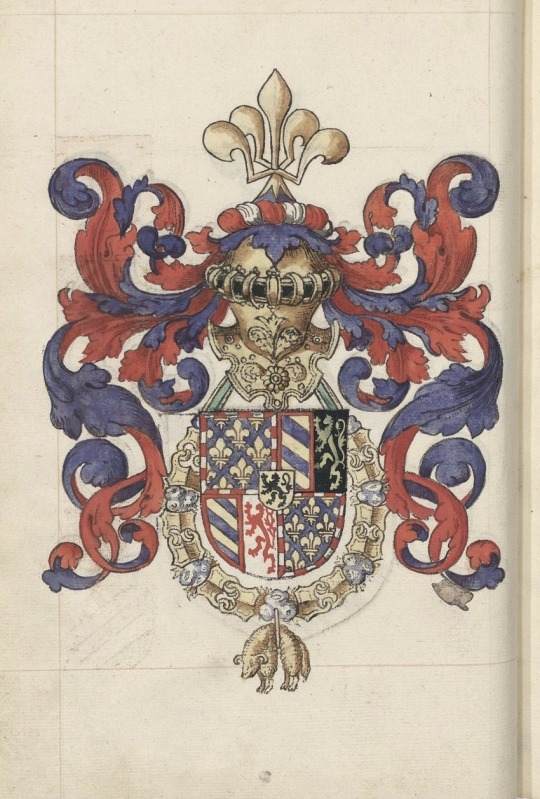
Coat of Arms of Charles the Bold (le Téméraire) Duke of Burgundy
#charles the bold#charles le téméraire#le téméraire#coat of arms#burgundy#burgundian#heraldry#history#europe#european#medieval#middle ages#burgundians#burgundian state#duke of burgundy#bourgogne#brabant#limburg#luxembourg#low countries#pay bas#grand armorial colorié
59 notes
·
View notes
Text
Some nations and their birth/death date
- Britannia : born around 800BCE (beginning of British Iron Age); died around 500CE, but she had been getting weaker ever since Rome's forces left.
- Rome : born in 753BCE (Rome's fonding); died in 476CE, for obvious reasons
- Gaul (celtic) : born around 700BCE (between the Halstatt and La Tène cultures); died not long after the Gallic wars in 52BCE
- Germania : born around 750BCE (Nordic Iron Age) died not long after Rome's fall
- Frankish Kingdom/Empire: died in 843 (Treaty of Verdun), son of Germania
- Burgundian Kingdom/State: died in 1482 (end of the Burgundian War of Succession), daughter of Germania
- Frisian Kingdom: died 1523 (end or Frisian Freedom after a failed Frisian rebellion), son of Germania (and is either the biological or the adopted father of the Low Countries (or at least the Netherlands))
- France: born shortly before the Gallic Wars, son of Gaul
- England: born around 500 CE (first Anglo-Saxon kingdoms), he would fully become his "own" in 927 with the Kingdom of England, son of Britannia
- Spain: born somewhere during the Roman era, son of Rome
- Portugal: same as Spain, but earlier, son of Rome
- Netherlands: born shortly before the Roman conquest of Gaul (Belgae), son of idk who yet
- HRE: born in 486CE, when the Franks beat the Soissons Domain; died 1806 for obvious reasons, son of the Frankish Kingdom
- Middle Francia/Lotharingia: born in 843CE (Treaty of Verdun); died either 958CE (division of the Kingdom of Lotharingia) or 1190CE (Lower Lotharingia lost its territorial authority), daughter of the Frankish Kingdom
- Austrasia & Neustria: born in 511CE, died in 751CE, those boys were literally twins and they started the tradition of ✨️fratricide✨️ in the family (later carried on by France killing HRE), sons of the Frankish Kingdom
- Prussia: born 1226CE (creation of the State of the Teutonic Order)/born 1th century CE if we consider him an Old Prussian (Baltic tribe), son of how do I know
- Germany: born...1806(Confederation of the Rhine), 1815(German Confederation), 1866 (North German Confederation) or 1871 (Proclamation of the Reich)
Or he's HRE according to some... I don't know he's complicated...
#feel absolutely free to propose other dates if you don't agree or think there can be another date#very west european/germanic centred sorry :(#i have no idea when Germania's children would be born tho so uh yeah sorry#mes blogs#hetalia#historical hetalia#aph rome#aph germania#aph gaul#aph britannia#aph frankish empire#aph burgundian state#aph frisian kingdom#aph france#aph england#aph spain#aph portugal#aph netherlands#aph hre#aph lotharingia#aph austrasia#aph neustria#aph prussia#aph germany#ill stop here thanks-#hetalia headcanons
46 notes
·
View notes
Note
Sorry if it's obvious, but I admit I'm a bit confused on there being both Dukes of Burgundy and also Counts of Burgundy and what's the difference?
Because the medieval border region between France and the HRE can't ever be straightforward and rational, there was both a Duchy and a County of Burgundy. And to make matters more confusing, they were right next to each other:
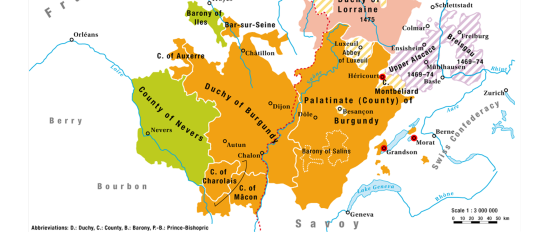
The most significant political difference between them is that the Duchy of Burgundy was part of the Kingdom of France (although they didn't always agree on that) and the County of Burgundy (better known as the Free County or the Franche-Comté) was part of the Holy Roman Empire.
However, and this is an example of how complicated medieval politics could get, both Burgundies were in personal union under the House of Valois-Burgundy, and thus were part of the Burgundian State that Charles the Bold very much wanted to make the core of his revived, independent, and coequal Kingdom of Burgundy. It didn't work out thanks to the Swiss pikemen and the treacherous Hapsburgs, but it came very close to becoming a thing.
44 notes
·
View notes
Text
The Golden Age of Dutch painting: a Prelude
Portrait of Susanna Lunden (née Fourment) or Le Chapeau de Paille, by Peter Paul Rubens (The National Gallery, London)
Suzanne Fourment Lunden, portrayed above, was Baroque Flemish artist Peter Paul Rubens‘s sister-in-law. In 1630, four years after Rubens’s first wife, Isabella Bran(d)t, died of the plague, fifty-three-year-old Rubens married sixteen-year-old Hélène Fourment. His first marriage…

View On WordPress
#Antwerp#Dutch Golden Age of painting#Eighty Years&039; War#Flanders#Flemish Baroque artist#Hélène Fourment#History#Peter Paul Rubens#Suzanne Lunden#The Burgundian State#The Duchy of Brabant#Twelve Years&039; Truce
1 note
·
View note
Text
queen zenobia is another good one for the drunk history ask.
#or eleanor of aquitaine#and the anarchy in general#or the kievan rus#or hypatia#the albigensian crusades#the burgundian state
0 notes
Text
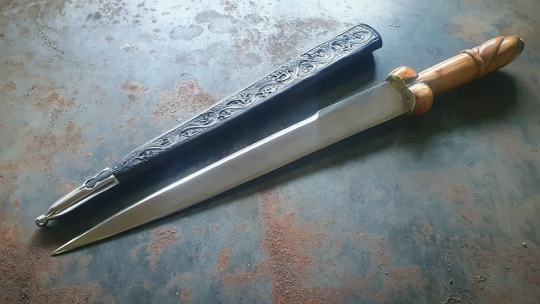
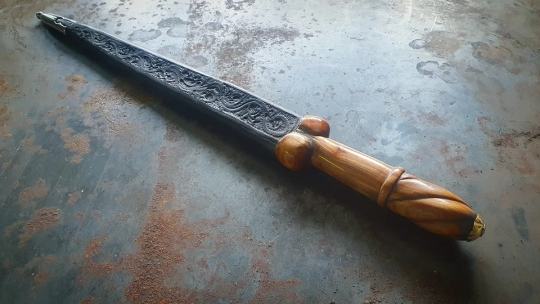
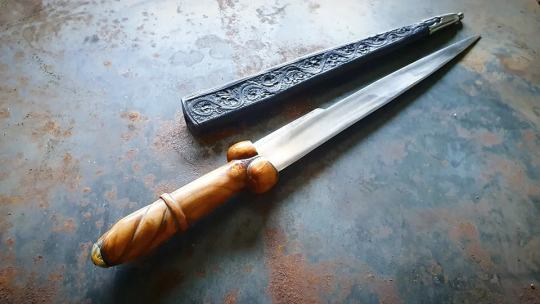
A Ballock Dagger, XVth century.
Inspired by various models popular in the northern parts of the powerful Burgundian states.
Blade is high carbon steel, with an elegant hollow grind and decorative false edge. Grip is cherry wood, with brass plate and end.
Carved and tooled vegetable tanned leather scabbard, and mild steel chape.
As always, everything is hand made.
There is an obvious anatomical analogy in the shape of these daggers, probably associated to some symbolism and nonverbal forms of communication that elude us, but which certainly explains their popularity from the XIVth century onwards.
236 notes
·
View notes
Text
Was thinking about the Firmament prologue with @awordbroken and went down a Wikipedia rabbit hole, starting with the War of the Roses, down to the Burgundian state, down to the city of Ghent, looked at duchesses from around the time of the War of the Roses, and landed on these two that possibly remind me of the Last Duchess' outfit (especially Mary). I'm not sure that everything lines up but I thought it was interesting nonetheless and we shall see



Regardless of all this. The War of the Roses was in the latter half of the 1400s and the fourth city fell in the 1100s right? So wonder if the G- city was meant to be the fifth city and the Masters mucked it up beyond repair
59 notes
·
View notes
Text
Pan-Turkism has been characterized by pseudoscientific theories known as Pseudo-Turkology.[64][65] Though dismissed in serious scholarship, scholars promoting such theories, often known as Pseudo-Turkologists,[64] have in recent times emerged among every Turkic nationality.[66][67] A leading light among them is Murad Adzhi, who insists that two hundred thousand years ago, "an advanced people of Turkic blood" were living in the Altai Mountains. These tall and blonde Turks are supposed to have founded the world's first state, Idel-Ural, 35,000 years ago, and to have migrated as far as the Americas.[66]
According to theories like the Turkish History Thesis, promoted by pseudo-scholars, the Turkic peoples are supposed to have migrated from Central Asia to the Middle East in the Neolithic. The Hittites, Sumerians, Babylonians, and ancient Egyptians are here classified as being of Turkic origin.[65][66][67][68] The Kurgan cultures of the early Bronze Age up to more recent times are also typically ascribed to Turkic peoples by pan-Turkic pseudoscholars, such as Ismail Miziev.[69] Non-Turkic peoples typically classified as Turkic, Turkish, Proto-Turkish or Turanian include Huns, Scythians, Sakas, Cimmerians, Medes, Parthians, Pannonian Avars, Caucasian Albanians, and various ethnic minorities in Turkic countries, such as Kurds.[69][70][71][67][68] Adzhi also considers Alans, Goths, Burgundians, Saxons, Alemanni, Angles, Lombards, and many Russians as Turks.[66] Only a few prominent peoples in history, such as Jews, Chinese people, Armenians, Greeks, Persians, and Scandinavians are considered non-Turkic by Adzhi.[66]
Philologist Mirfatyh Zakiev, former Chairman of the Supreme Soviet of the Tatar ASSR, has published hundreds of "scientific" works on the subject, suggesting Turkic origins of the Sumerian, Greek, Icelandic, Etruscan and Minoan languages. Zakiev contends that "proto-Turkish is the starting point of the Indo-European languages".[66] Not only peoples and cultures, but also prominent individuals, such as Saint George, Peter the Great, Mikhail Kutuzov and Fyodor Dostoevsky, are proclaimed to have been "of Turkic origin".[66] As such the Turkic peoples are supposed to have once been the "benevolent conquerors" of the peoples of most of Eurasia, who thus owe them "a huge cultural debt".[66][72]
The pseudoscientific Sun Language Theory states that all human languages are descendants of a proto-Turkic language and was developed by the Turkish president Mustafa Kemal Atatürk during the 1930s.[73] Kairat Zakiryanov considers the Japanese and Kazakhgene pools to be identical.[74] Several Turkish academics (Şevket Koçsoy, Özkan İzgi, Emel Esin) claim that Zhou dynasty were of Turkic origins.[75][76][77][78]
what is going on with the turkish
341 notes
·
View notes
Photo
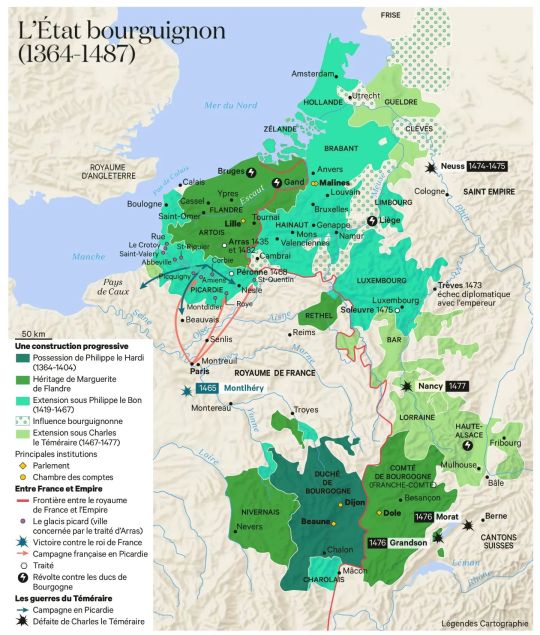
The Burgundian state, 1364-1487.
« Atlas historique mondial », Christian Grataloup, Les Arènes/L'Histoire, 2e éd., 2023
by cartesdhistoire
In 1363, the king of France, John the Good, gave Burgundy as an appanage to his son Philippe the Bold. Duke until 1404, he became master of a vast area, including Charolais, Artois, Franche-Comté, Rethel, Nevers and Brabant. His power made Flanders independent and it was a solid base for expansion in the Empire, continued by Duke Philip the Good (1419-1467): Namur, Hainaut, Holland, Zeeland and Luxembourg ( in addition to a nebula of satellites like the ecclesiastical principalities of Liège, Utrecht and even Cologne).
The Burgundian “State” is therefore made up of two blocks of territories, both shared between France and the Empire: Burgundy (France) and Franche-Comté (Empire) are governed from Dijon; from Lille then from Brussels from 1430, Flanders, Artois (France) and the Netherlands (Empire). The frequent meeting of States within the framework of each province allows regular taxation, which makes the Duke one of the richest sovereigns in the West, the bulk of his income coming from Flanders and the Netherlands. The administrative structure is close to that of the French monarchy (aids, Chambers of Accounts, states, Parliament).
Duke Charles the Bold (1467-1477) tried to reunite the two blocks, barely 60 km apart after 1441. He centralized, increased taxes and borrowed enormous sums from banks to obtain an imposing army and artillery. He then aimed for Lorraine and the archbishopric of Cologne but his ambitions united his enemies against him: Louis XI, the emperor, Lorraine, Savoy and the Swiss. In 1475, the Swiss crushed Charles's army at Grandson and Morat then the duke died in 1477, trying to retake Nancy. He is succeeded by his daughter Marie who married Maximilien, son of the emperor. She died on March 27, 1482 and on December 23, the Treaty of Arras divided her inheritance between Valois and Habsburg.
43 notes
·
View notes
Text
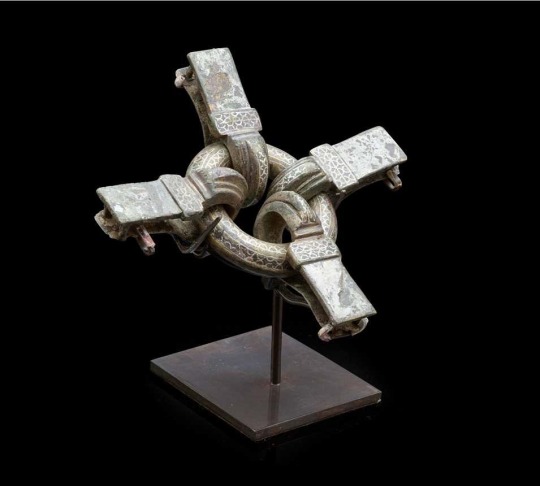
MEROVINGIAN PENDANT
WESTERN EUROPE, CIRCA 7TH CENTURY A.D.
Ncast metal ring with four loop straps
The Merovingian dynasty was the ruling family of the Franks from the middle of the 5th century until 751. They first appear as "Kings of the Franks" in the Roman army of northern Gaul. By 509 they had united all the Franks and northern Gallo-Romans under their rule. They conquered most of Gaul, defeating the Visigoths (507) and the Burgundians (534), and also extended their rule into Raetia (537). In Germania, the Alemanni, Bavarii and Saxons accepted their lordship. The Merovingian realm was the largest and most powerful of the states of western Europe following the breaking up of the empire of Theodoric the Great. Wiki
Lyon and Turnbull
15 notes
·
View notes
Text
Random thoughts about pikemen in AoE2
DLC dropping the Swiss and a German state like Swabians or some shit or other, as well as tweaking the Celts to be more like Scots and adding pikemen to several of the fanciest civs.
Changelog:
Celts get Gallowglass instead of Woad Warriors, it changes nothing except for their name and how they look.
Celts get bombard cannons.
Swiss, Swabian, Celts, Burgundians, Italians, Spanish and maybe Franks get pikemen instead of halberdiers, rename the old pikemen to voulgiers or some shit (you know something they clearly are, for a change).
Pikemen have the same stats as the previous pikemen but one more range.
Swiss, Swabians and Celts have specific bonuses for them, maybe speed, HP, and a Georgian-like group bonus respectively.
The German state would probably have a hairy dude with a greatsword as a unique unit doing full trample damage with a bonus against pikemen, Switzerland I'm still unsure there are several possibilities.
Generally tho I always thought a civ should have a gunpowder scorpion in the form of a falconet or something.
16 notes
·
View notes
Text
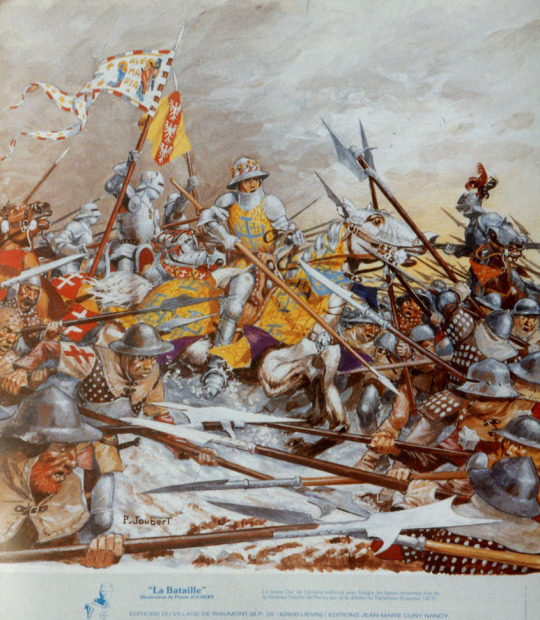
The Battle of Nancy 1477
#battle of nancy#1477#charles le téméraire#charles the bold#burgundian wars#burgundy#art#history#europe#european#knights#medieval#france#middle ages#burgundian state#duchy of lorraine#swiss confederacy#swiss#burgundian#armour#rené ii#duke of lorraine#lorraine#pierre joubert#la bataille de nancy
33 notes
·
View notes
Quote
Charles the Bold was an ardent propagandist, sending out letters to local authorities justifying his policies, circulating inspiring accounts of great court festivities, expounding his view of princely powers and duties in the preambles to his ordinances and continuing the Burgundian tradition of a workshop of court historians fashioning favourable versions of the past and present. Edward IV began to commission similar official chronicles after his return from exile in the Netherlands, and made a practice of issuing royal proclamations in full and sometimes self-justificatory English texts, rather than bald Latin instructions to announce certain information.
Steven Gunn, State Development in England and the Burgundian Dominions, c.1460-c.1560
But it was Henry VII, perhaps inspired by Maximilian’s enthusiastic perpetuation of the Burgundian penchant for propaganda, who first appointed a court historian, first circulated accounts of diplomatics festivities (and did so in print), used fuller proclamations and the preambles to parliamentary statues — likewise printed by the king’s printer from 1504 — to explain himself to his people, and wrote to local authorities ordering celebrations of such successes as the Anglo-Burgundian marriage treaty of 1507 and expounding on their significance.
#as usual: henry vii wasn't an innovator#but simply very good at his job#edward iv#henry vii#charles the bold#historian: steven gunn
18 notes
·
View notes
Text
A Guildsman Goes Forth to War, Inciting Event and Main Characters
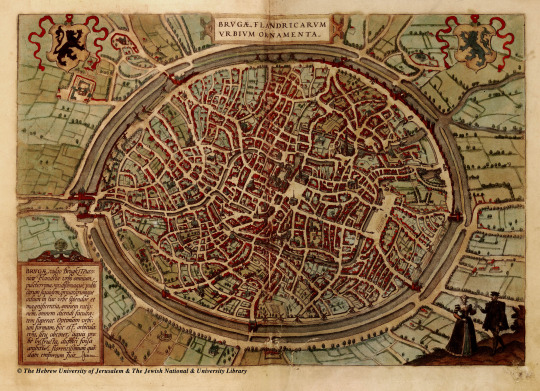
Inciting Event:
The city of Brugghe is one of the largest and richest in all of Europe. It is a center of vertically- and horizontally-integrated textile production in wool, cotton, linen, and silk, and the people wear their reputation on their richly-dyed, patterned, and embroidered backs. As the northernmost of the cloth fairs that stretch all the way from Gallia to the southernmost reaches of the ancient Kingdom of Lotharingia), and the confluence of the North Sea and the Rhine, Brugghe is a natural entrepôt between the merchants of the Hansa and the commercial republics of the Lega, and thus one of the leading financial centers on the Continent.
A bustling cosmopolis of two hundred thousand souls, with a lively Foreign Quarter representing merchants and bankers from Portugal and the Basques to a half-dozen Lega republics to representatives of the Sublime Porte. In Brugghe, even the poorest and least educated rural migrants are bilingual (even if they insist on speaking only Gallician or Imperial), a respectable burgher is expected to speak at least four, and a man is considered educated only if he speaks six. A center of the printing trade (and thanks to its dyeing industry, a lively art scene), it is an unusually literate city, only more so thanks to the recently-established University.
For the last thirty years, the city has been ruled by the tolerant but firm hand of Baron Froederick van Zonder Vrees, although for the last ten the day-to-day governance has been conducted in his name by his significantly younger wife due to a long and lingering illness that has forced the Baron to a sickbed and (accoridng to reports) to his deathbed. Although by all reports a loving and capable partnership, the Baron and Baronness are childless. If the Baron should pass, what shall become of Brugghe?
Main Characters:

Margrit van Zonder Vrees (née Marguerite de Corbenic), Baronness of Brugghe
The daughter of a noble family from Brittany (with extended ties to Cornwall and south Wales) with a strong Gentry heritage of elfkind, Margrit (or Marguerite, depending on whether she's speaking in Gallician or Imperial) was sent to the Burgundian court following a romantic indescretion in her youth, where she became one of the court beauties and a poetess beside, reknowned for the strength of her Glamour and wit alike.
At the age of twenty, she was married to the significantly older Froederick van Zonder Vrees as part of diplomatic efforts to maintain Gallician/Imperial harmony in the Low Countries. Despite the age gap between the two, Froederick came to respect his bride's surprisingly well-educated mind and supported her patronage of the newly-founded University and the city's cultural industries, while Margrit came to admire her husband's commitment to light-handed and tolerant governance that had seen Brugghe reach heights of prosperity that it had not seen since the collapse of the Flemish revolt.
When Froederick began to fall ill, Margrit smoothly gained influence within the Baronial Council of State that governed the city until she became the Regent in all but name. At the outset of A Guildsman Goes Forth to War, Marguerite's dilemma is that she has no child to pass the title to upon her husband's death - and due to the complicated mix of family intermarriages, there will be claimants from both the Kingdom of Gallia and the Sacrum Imperium.
[Need to find a good picture]
Ludovico "Malasangue," Captain-General of the Bonafortuna Mercenary and Insurance Company, graduate of the University of Padua, and guildsman of the Arte dei Giudici e Notai of Florentia.
The younger son of the Bilancia banking family, Ludovico was the subject of considerable scandal, for from birth it was quite clear that he was Gentry-born of some rare and unknown lineage, while neither his mother nor his father had any such connexions. A brawler of violent temper, Ludovico was packed off to Padua by his decidely chilly and aloof father to avoid embarrassment - and to ensure that he would have a career that would avoid any interference with his older (some would say "legitimate") brother's inheritance of the family business.
The curriculum at the great university of the hills seemed to calm the intemperate youth and Ludo proved to be quite adept at both the Old Learning of the trivium et quadrivium, the New Learning of the studia humanitatis, and his chosen degree in Law. It was widely expected that, upon his graduation and return to the city of his birth, he would take up a respectable and conventional career in the leading Arti Maggiori. Thus, it came as something of a surprise when instead Ludovico and some of his university friends announced the formation of a new kind of mercenary company.
The Bonafortuna Mercenary and Insurance Company would be made up not of impoverished noblemen and ambitious peasants, but entirely of urban guildsmen recruited from among the Lega. In times of peace, the Company would make its income from providing a comprehensive suite of services from messenger and parcel post to commercial and residential insurance to private security, to individual and municipal clients alike - with significant discounts for joint customers of the condottieri side of the business.
26 notes
·
View notes
Note
Hi! Sorry to disturb, but I’m very interested in one thing. When do you think was Francis born?
I'm not decided on Francis yet, but I have a few dates that could work:
anywhere between 260-274 AD: the Gallic Empire breaks off from the Roman Empire and functions as an autonomous state until reconquered by the Romans in 274. this lets Francis be born Gallo-Roman and be 'adopted' by the Franks, which would mirror Arthur's backstory.
286 AD: Roman Commander Carausius declares himself emperor of Britain and northern Gaul. you once again have Gaul as a Gallo-Roman-now slightly Frankish breakaway state as all three cultures exist together.
418 AD: Aquitaine is given to the Goths. not as solid logic here except that the story idea of the Romans giving away baby Francis as a sign of 'fine, your territory now' just really got me.
anywhere between 455 AD and 476ish works, as the Romans withdrew and the Visigoths, Burgundians, and Franks move in.
481 AD: that motherfucker Clovis suddenly shows up on the historical record and starts just wrecking shit for the Franks. beginning of the Merovingian conquest of France.
486 AD: Battle of Soissons, and the establishment/unification of Merovingian France. since this is when Franks finally rule all of France, this is kinda seen as the point where Gaul becomes France. or Francia or whatever.
Uuuhhh yeah I personally don't really put his birth any earlier than the Crisis of the Third Century or later than Soissons, though you can do whatever you want.
26 notes
·
View notes
Text
Knightfall and Hundred Years' War
It's me, back again with more Knightfall theorizing via Joan of Arc references. I briefly touched on this in one of my previous theories, but Hundred Years' War as a setting itself can be used as a material to theorize.
First of all, what was Hundred Years' War and why does it matter? It was war between France and English over French royal succession that lasted with some breaks more than hundred years (duh). Generational bitter conflict can be translated in RWBY in multiple ways. It can represent strife between the kingdoms, it can represent strife between Humans and Faunus and it can represent conflict between Salem and Ozma.
While there certainly are tensions between the kingdoms, they are mostly resolved and have very little to do with Jaune. Same with Human-Faunus conflict, which has even less to do with Jaune. This leaves us with Salem-Ozma conflict in which Jaune is active player.
There are also parallels one can draw between Salem-Ozma conflict and Hundred Years' War. Both are impossibly long wars lasting generations. Both were started between parties that were connected with marriage. Salem and Ozma were of course married, while French and English royals had marital connections. Reason why English even claimed French crown in the first place was because English King was married to the daughter of former French King. And as I stated in my previous theories, Salem and Grimm relatively consistently represent English when looking at RWBY from the position of Jaune as Joan of Arc.
______________________________________________________________
Cool, but what does it have to do with Knightfall as a pairing? Well, Jaune's primary literary allusion is Joan of Arc and while Cinder fits variety of characters from Joan's story, she fits the most as French King at the time, Charles VII (who will be referred to as Dauphin from now on). As for how she fits the role, I will slap the link to the theory below.
Meeting between Joan and Dauphin was the catalyst that ended up turning the war in French favor. Prior to that moment, French were getting pushed back more and more by Anglo-Burgundian forces who were sieging Orleans at the time, one of the key French strongholds. Dauphin and his followers were losing the faith in the war, with Dauphin even looking to escape to allied kingdom of Aragon. Meeting with Joan gave back the hope to Dauphin and with her supposed divine abilities she managed to help the French forces win the fight at Orleans.
While relationship between Joan and Dauphin was completely platonic, I feel like if they ever give Jaune love interest that somewhat follows his literary allusion, it would have to be character that is reference to Dauphin. It's pretty clear that writers are subverting both Joan's virginity and her unattractiveness with Jaune (he is basically in universe thirst trap which is inversion of Joan repeatedly being described as unattractive by her male companions). After all, Dauphin was Joan's one and only.
Reason I go over this is because if writers are staying true to the setting of Joan of Arc story, then it needs to be high stakes romance subplot. There is a difference between stakes in Joan of Arc story and lets say Cinderella or Snow White story. If Cinderella didn't meet her Prince, she would probably spend the rest of her life as abused servant. If Snow White didn't met her Prince, she'd remain dead. That's sad and all, but it has no influence on the rest of the world. If Joan didn't meet Dauphin, it's likely French would have lost and be subjugated by the English, especially when you read more romanticized versions of the story that emphasize Joan's role in the war.
That's why I gravitate towards Knightfall. If Jaune ever redeems Cinder, that's a game changer. Salem loses her most powerful henchman as well as access to the final Relic. You don't get that kind of stakes with something like Whiteknight. Jaune romancing or not romancing Weiss has no influence on the greater picture.
_____________________________________________________________
Last thing to add is supposed ancient prophecy (started by Merlin in some version of the story) that circulated during the late stage of Hundred Years' War. It goes "France would be ruined through a woman and afterwards restored by a virgin". Joan herself often quoted that prophecy and saw herself as prophesized virgin savior. Woman that prophecy refers to was Dauphin's mother, Isabeau of Bavaria who was often blamed for French misfortune due to her debauchery and cooperation with English.
This can be interpreted in variety of ways. First is the state of the world itself. Reason the world is broken is Salem's feud with Gods and her conflict with Ozma. So to restore the world, one would have to do the opposite. This is were Reverse Ozlem theory comes in.
https://www.tumblr.com/ficretus/743569593949388800/knightfall-and-ozlem?source=share
Jaune and Cinder have lot of Ozma-Salem imagery in their characters and encounters, but they seem to be going in reverse chronologically. End point of that theory would be Jaune and Cinder making amends. Ozma and Salem went from lovers to enemies, which ended up tearing the world apart. Jaune and Cinder would go from enemies to partners and fix the world through their cooperation.
Other interpretation would shift France in prophecy to Dauphin. After all, Kings were seen as representatives of their countries and Isabeau not only ruined France, she ruined her son as well. What "ruined" Cinder and set her on destructive path she walks in the story is her abusive childhood. I previously paralleled Isabeau and Madame because of the role they play in childhood of their respective characters. If Cinder was ruined by being unloved, then she can be saved by being loved. If she was ruined by being convinced she was worthless, she can be saved by someone telling her she is worthy. Latter one works especially well as a parallel to Joan of Arc story since Dauphin questioned his own worth until Joan assured him he is rightful King.
Last interpretation is offshoot of previous one, but shifts blame from Madame to Rhodes. Rhodes was aware of Cinder's abuse, yet did nothing substantial to stop it. He symbolically represents Huntsman society as a whole, turning a blind eye. So if Cinder was ruined because Huntsman wouldn't help her, then she can be saved by Huntsman noticing her.
_____________________________________________________________
This is it for this one. What are your thoughts? Feel free to comment if you have your own interpretations or think I missed something.
5 notes
·
View notes